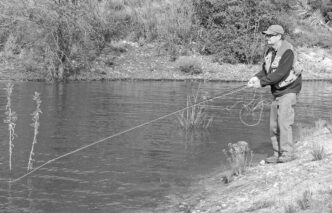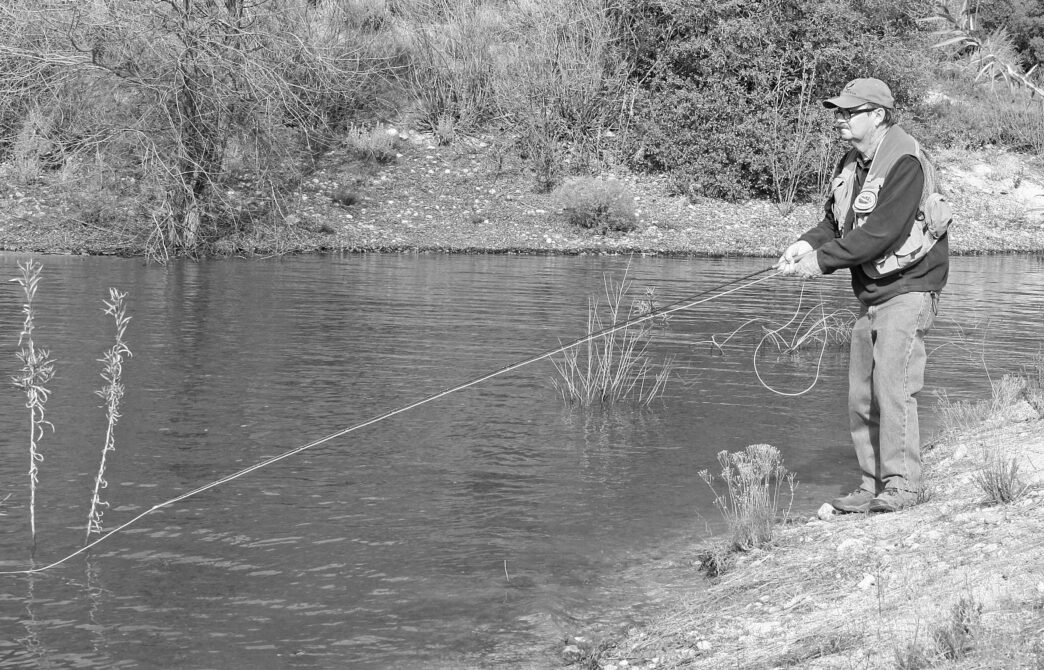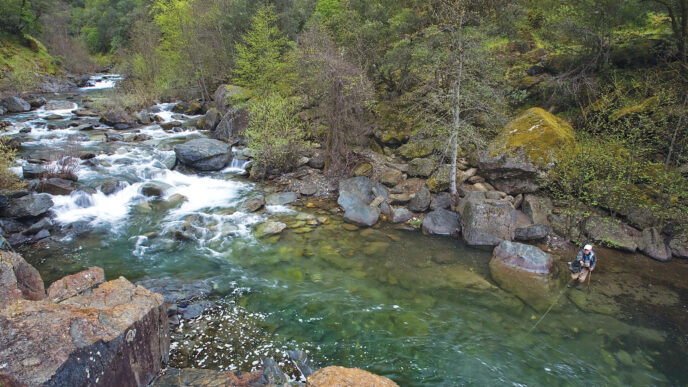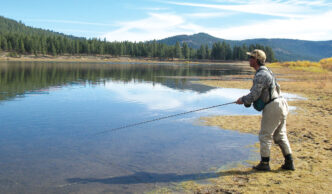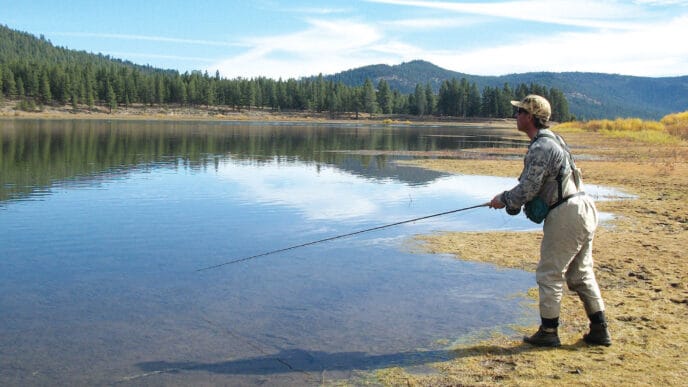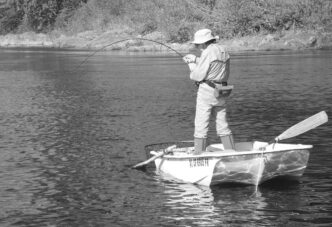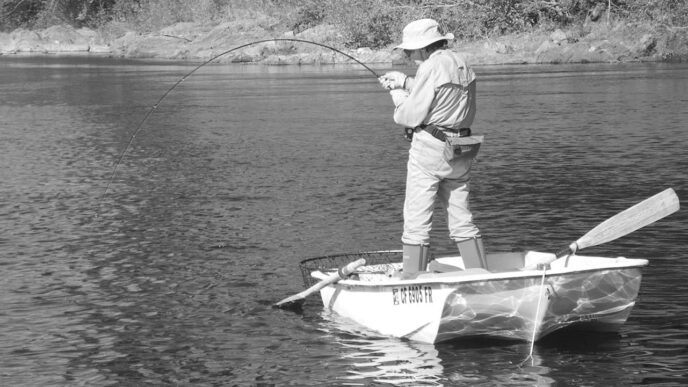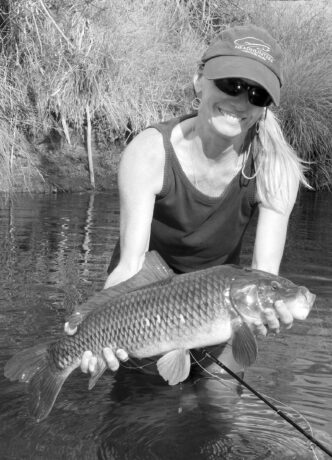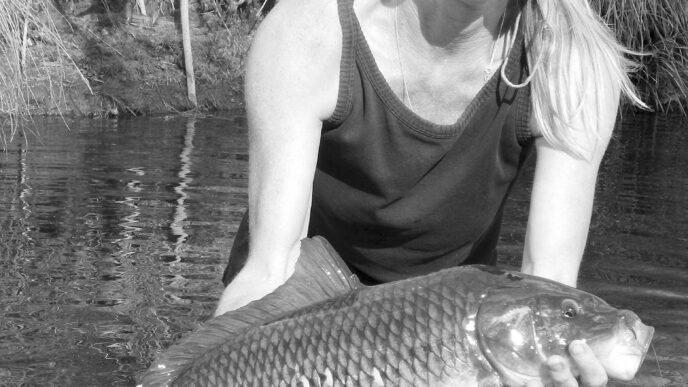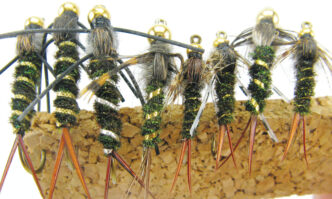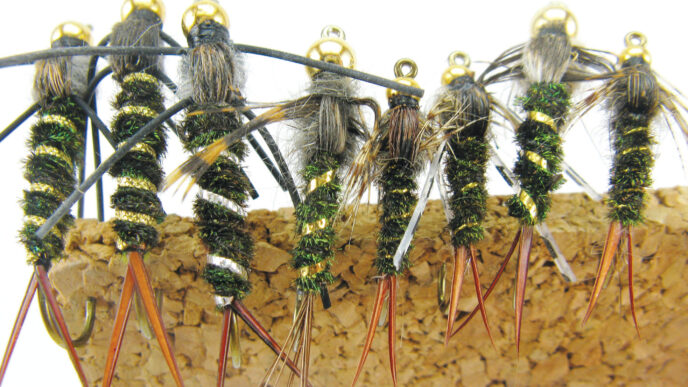Anglers are always asking me about the differences between fly fishing on ponds and lakes for bass and fly fishing on streams for trout. There are many, but the one that comes to mind first is the retrieve.
When you fish flowing water, you usually want the current to carry your fly like a natural insect. Your fly begins its downstream journey the moment it touches the moving surface of the stream. It’s often quite a surprise to the beginning angler. I know it was to me. I had gathered up my sparse load of tackle and flies and had accepted an invitation from two older members of the fly-fishing club I had just joined to go with them to Deep Creek, high in the San Bernardino National Forest, to fish for trout — something I’d not done since I was a kid. It had been 20 years since I had held a fly rod over flowing water. Whatever fly-fishing and rod-handling lessons I’d learned back then had been long forgotten.
Oh, I knew how to cast a fly in a more or less straightforward manner. It was what happened next that caught me unprepared. The line hit the water upstream and the Adams dry fly floated beautifully, but then the line started sliding back toward me at an alarming rate. I knew I was supposed to retrieve the line, but there’s a big difference between “knowing” a thing and having to apply it suddenly. As it was, I flubbed the whole retrieve and wound up with 20 feet of line and leader looped around my legs.
The experience seems humorous today, but I really didn’t know what to do once my fly and line touched down on the water. After untangling myself and getting the line spooled on the reel again, I thought about what had just happened, and with slightly shaky hands, I tried it again. This time, a hint of my lawn-casting training kicked in, and I managed to slip the line under my right forefinger and start stripping in line with my left hand before a repeat of the first cast could occur. I was only partly successful, but over the next 20 minutes or so, I more or less got the hang of it, and by the time half an hour had flown by, I was casting and retrieving in a series of motions that were almost right.
After practicing this new art, I moved upstream one pool and actually had a strike. One damn-fool trout forgot he was supposed to be sensitive and spooky and managed to impale himself on my size 16 Adams. I had caught a trout!
Manipulation of the fly line in moving water is intended to match the downstream pace of the fly so it makes no odd motions that would reveal it for what it actually is and keep the trout from eating it. Your objective is to eliminate any suggestion of drag — at least for dry-fly and nymph fishing.
The retrieve in still waters is totally different. It has nothing to do with eliminating drag and everything to do with making your fly seem alive. There’s a huge difference, of course, between matching the speed of your retrieve so the fly doesn’t drag in the current and using the retrieve to simulate the movements of a living creature where there are no currents.
Since most of us do our fly fishing with single-action fly reels, we don’t retrieve line with the reel. That may be why some of the old bass flyrodders in the South stayed with their out-of-style, heavy, automatic fly reels. You can pick up a lot of line quickly by just clicking the lever on the reel.
Actually, the first type of “retrieve” I use is not a retrieve at all. I cast the fly or bug to where I suspect a bass is hiding and then simply wait until all the ripples of the bug’s splashdown have disappeared. This do-nothing approach works. It’s especially good when fishing with deer hair bugs that drop gently to the surface.
A friend of mine refers to the do nothing presentation as his “heart starter,” because the explosive take you sometimes get after the bug has sat there doing nothing in particular for perhaps a minute will almost certainly cause your blood pressure to rise quite suddenly.
At the other end of the spectrum, there’s retrieving the fly as fast as you can, using both hands to strip in the fly line while the rod is stuck under your arm. This simulates a baitfish fleeing for its life. I try to combine all the various retrieves, starting with the do-nothing cast and going all the way up to panicked-baitfish mode. And there’s a lot you can do with a bass bug or fly that falls between the do-nothing and the two-handed panicked baitfish retrieve.
When fishing a sinking line with a fly that mimics a crayfish or a worm and with the fly in contact with the bottom, a very slow crawl retrieve works best. Actually, the way a crayfish fly is tied on the hook indicates how you should retrieve it. Crayfish crawl head first, so a crawling crayfish fly should be tied so the head end of your crayfish creation is at the eye end of the hook. You retrieve this fly in a smooth, very slow retrieve. A finger-twist retrieve works very well for this. With a little practice, you can crawl the fly so smoothly, it looks like an undisturbed crayfish (or other bottom-dwelling critter, such as a dragonfly nymph) crawling slowly over the bottom.
If the fly is tied so the crayfish’s head is at the hook bend, it needs to be retrieved with a quick strip of the line, repeated several times, then paused. This retrieve correctly mimics the backward escape motion of a crayfish using its broad tail to take it rapidly out of range of a bass.
Practice imitating the crayfish’s quick, backward-darting escape motion in shallow water, where you can see the fly. Try to make your imitation dart backward quickly, stirring up a little cloud of mud each time the crayfish would have flicked its tail. Sometimes you’ll spot these bursts of mud in real life, and it will be your first clue that a bass is in the area and chasing crayfish. I tie crayfish patterns facing in both directions, so I always have at least one or two in my box to mimic whichever behavior I need to imitate.
By contrast, most baitfish are quick moving creatures, and you’ll be imitating them with short to medium strips of line. A strip of six inches to one foot will suggest the motion of most baitfish. Usually, baitfish move fairly smoothly when not being pursued. Once they know they are the object of big jaws and empty stomachs, they dart about in a series of quick motions of short length. This darting motion extends over longer distances as the predator gets closer to them and finally goes becomes a high-speed fleeing motion, which is what you imitate if you strip line with both hands.
Part of your retrieve selection with a streamer will depend on how much weight is in the streamer’s head and body. With a pattern like a Clouser Minnow, which has weight in the head area, you want mostly short strips to make the fly twitch and bob up and down in the water column. I often use a modified Clouser that has a tiny Colorado spinner blade added under the chin of the fly. It’s called a Coyote and does a great job attracting bass and other predators in dingy water. I keep it moving during most of the retrieve so the spinner flutters. This produces both a flash of light and a vibration that predators can sense with their lateral lines. I work the Coyote fairly quickly for several feet, then pause and let it sink. After it has fluttered down a few feet, I pick up the retrieve again, then repeat that general rhythm.
Any fly constructed to make noise or vibration should be retrieved so it produces the maximum amount of disturbance to attract the attention of bass or other warmwater species. I think of the Flashtail Whistler, designed by Dan Blanton for Northern California’s striped bass, as a typical noise-making streamer fly. It needs to be retrieved so the bead-chain eyes, hackle and other body components push water in a way that will get a bass or striper headed in your direction.
A slender “traditional” streamer fly, such as a Lefty’s Deceiver, doesn’t make a lot of disturbance in the water, but instead relies on color and flash to attract a bass visually. These flies you can retrieve quickly, or you can just drift them along with a finger-twist retrieve.
Larry Dahlberg’s floating-diving streamer bug gets a series of quick strips with a pause between each strip. I think this motion accurately mimics a frog. The first strip gets the fly under the surface, and subsequent strips take the fly deeper, much like a live frog diving to hide in a weed bed. On a sinking line, you can fish it over weeds without getting hung up (at least not often), and it really does resemble a frog — better than any other pattern I’ve tried.
With a bit of practice, though, you can make almost any fly or bug that imitates a frog perform this way. You should practice this retrieve in a swimming pool or other spot with really clear water so you can see exactly what the fly is doing. I like to take new subsurface flies over to my son-in-law’s house and inspect their action in a swimming pool before actually fishing them. It’s a great test lab for seeing what the fly is doing and how much action you need to give it. Afterward, be sure and rinse the fly that you subjected to this testing, because the chlorine in pool water apparently tastes awful to bass. I’ve had bass close on a fly that hadn’t been rinsed and suddenly stop as if they’d been smacked on the nose.
One more thing. Don’t get into the habit of using the rod tip as a tool for twitching the line during a retrieve. You want to keep the rod tip pointed at the fly (or at least pointed where you think the fly is) and make your manipulations by stripping line with your hand. This creates your most direct connection with the fly, which helps ensure you are providing the appropriate action and also enhances your ability to detect and react to a fish that takes the fly. Yes, there are times when the rod tip can be used to make a floating fly quiver without really moving, but don’t try to do this with a sinking line and fly.
It takes a bit of work to make the transition from presenting a fly to trout on moving water with no added movement to making the fly move like a live creature in still water. Practice it when you can, then put it into practice when you fish lakes and ponds.



